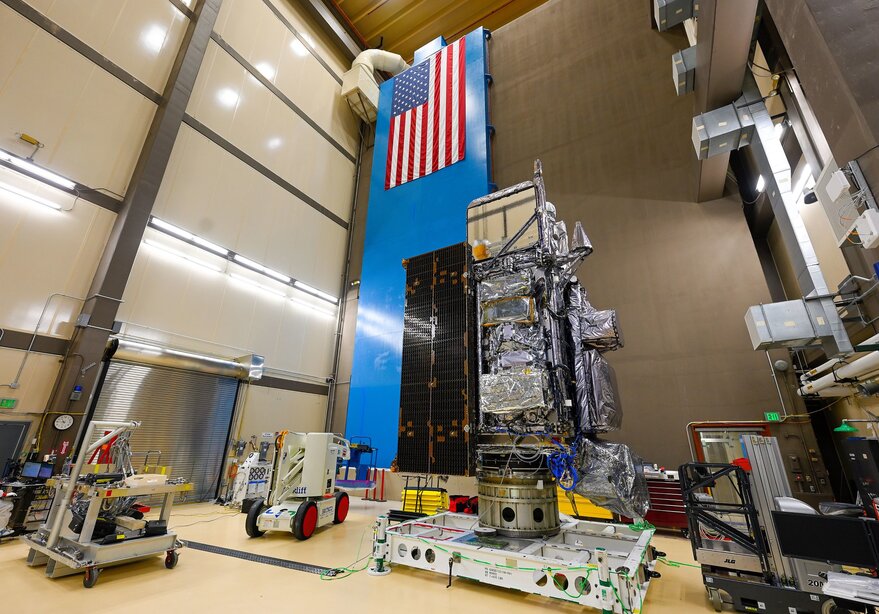
SAN FRANCISCO – The primary difference between the geostationary weather satellite scheduled to launch June 25 from NASA’s Kennedy Space Center in Florida and its predecessors is its solar-viewing instrument.
Unlike the other three satellites in the Geostationary Operational Environmental Satellite-R series, GOES-U, set to takeoff at 5:16 pm Eastern Time June 25 on a SpaceX Falcon Heavy rocket, carries a Compact Coronagraph built by the Naval Research Laboratory.
“The Compact Coronagraph, or CCOR, is a new instrument for GOES-U that will detect the white light of the upper solar corona, the outer layer of the sun, and deliver imagery back to Earth for use at our Space Weather Prediction Center within 30 minutes,” Jordan Gerth, National Oceanic and Atmospheric Administration National Weather Service meteorologist, said during a May 29 press briefing. “This is a vast improvement compared to our current system which can take up to eight hours to get data.”
Meteorologists currently obtain coronal imagery from the Large Angle and Spectrometric Coronagraph on the European Space Agency-NASA Solar and Heliospheric Observatory (SOHO), launched in 1995. Because few ground stations are able to communicate with the SOHO, “we can’t get the data in as fast as we want,” said Elsayed Talaat, director of NOAA’s Office of Space Weather Observations.
Overall, SOHO is “an aging satellite that is going to be power-limited in a year or two,” Talaat said. “So we are in a race to get this coronagraph up.”
CCOR will be mounted on a GOES-U platform facing the sun, alongside Lockheed Martin’s Solar Ultraviolet Imager, and the Extreme Ultraviolet and X-ray Irradiance Sensors from the University of Colorado, Boulder, Laboratory for Atmospheric and Space Physics.
Working together, the instruments “will see and sense the solar wind, solar flares and coronal mass ejections that can send billions of tons of highly magnetized material hurtling towards Earth at several million miles an hour,” Talaat said. “This material, as we saw in the recent storms, causes geomagnetic effects, which can trigger widespread damage to electric power grids that power communities as well as impact satellites, communications and navigation systems.”
Lessons Learned
In other respects, GOES-U is much like the other GOES-R satellites. All are the size of small school buses. And they have the same primary instrument: the Advanced Baseline Imager, built by L3Harris Technologies, which gathers imagery of Earth’s weather, oceans and environment in 16 spectral bands.
The GOES-R satellites also are equipped with Lockheed Martin Geostationary Lighting Mappers, magnetometers and the Space Environment In-Situ Suite from Assurance Technology Corp., which includes sensors to monitor protons, electrons and heavy ion fluxes in the magnetosphere.
“The plan from the beginning has been for the four GOES-R series spacecraft to be virtually the same model,” said John Deily, GOES-R flight project manager, NASA Goddard Space Flight Center.
Even so, NASA incorporated “all the upgrades and lessons learned from the development and operation of the first three spacecraft,” Deily said.
When it reaches geostationary orbit, GOES-U will be renamed GOES-19. After on-orbit checkout, GOES-19 will replace GOES-16 in the GOES-East orbital slot at 75 degrees west. If all goes as planned, meteorologists will have access to GOES-19 imagery and data by spring.
- SEO Powered Content & PR Distribution. Get Amplified Today.
- PlatoData.Network Vertical Generative Ai. Empower Yourself. Access Here.
- PlatoAiStream. Web3 Intelligence. Knowledge Amplified. Access Here.
- PlatoESG. Carbon, CleanTech, Energy, Environment, Solar, Waste Management. Access Here.
- PlatoHealth. Biotech and Clinical Trials Intelligence. Access Here.
- Source: https://spacenews.com/goes-u-nears-launch-with-a-new-sun-sensor/



